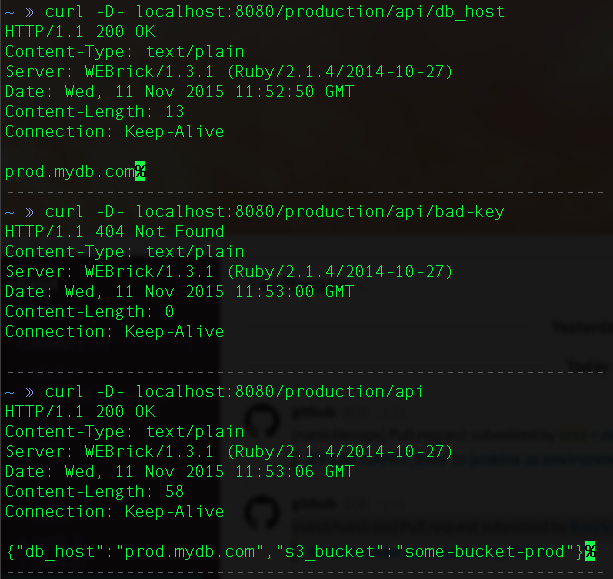ConfigServer
The simplest way to store YAML configuration and server it over HTTP
Installation
Add this line to your application's Gemfile:
gem 'config_server'
And then execute:
$ bundle
Or install it yourself as:
$ gem install config_server
Usage
To run the server you must have a configuration file first:
#config.yml
production:
api:
db_host: prod.mydb.com
s3_bucket: some-bucket-prod
nginx:
server_name: www.me.prod
staging:
api:
db_host: staging.mydb.com
s3_bucket: some-bucket-staging
nginx:
server_name: www.me.staging
Then create the following ruby file:
#my_configuration_server.rb
require 'config_server'
ConfigServer.start("config.yml")
and run bundle exec ruby my_configuration_server.rb
You can now query the server:
- In the first example we get the production db host for the api service
- In the second example we ask for a non existing key and get a 404 response
- In the third example we ask for a key which has a hash value. We get a JSON representation of it.

Development
After checking out the repo, run bin/setup to install dependencies. Then, run rake spec to run the tests. You can also run bin/console for an interactive prompt that will allow you to experiment.
To install this gem onto your local machine, run bundle exec rake install. To release a new version, update the version number in version.rb, and then run bundle exec rake release, which will create a git tag for the version, push git commits and tags, and push the .gem file to rubygems.org.
Contributing
Bug reports and pull requests are welcome on GitHub at https://github.com/[USERNAME]/config_server. This project is intended to be a safe, welcoming space for collaboration, and contributors are expected to adhere to the Contributor Covenant code of conduct.
License
The gem is available as open source under the terms of the MIT License.